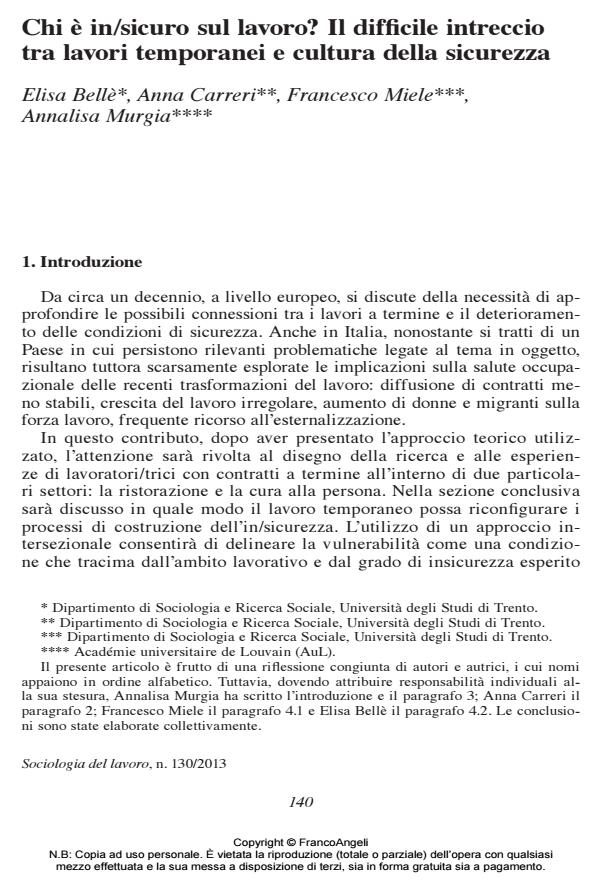Who is (un)safe at work? The difficult intertwining between temporary work and safety culture
Journal title SOCIOLOGIA DEL LAVORO
Author/s Elisa Bellè, Anna Carreri, Francesco Miele, Annalisa Murgia
Publishing Year 2013 Issue 2013/130 Language Italian
Pages 14 P. 140-153 File size 273 KB
DOI 10.3280/SL2013-130009
DOI is like a bar code for intellectual property: to have more infomation
click here
Below, you can see the article first page
If you want to buy this article in PDF format, you can do it, following the instructions to buy download credits

FrancoAngeli is member of Publishers International Linking Association, Inc (PILA), a not-for-profit association which run the CrossRef service enabling links to and from online scholarly content.
The article aims at understanding how temporary work can lead to a reconfiguration of the processes of construction of (un)safety in the workplace. With this goal, the present contribution focuses on some of the interviews that have been gathered within the scope of a research on the relations between safety conditions and temporary work in the tourism industry and the health and social care sector. Firstly, it is underlined that what prevents people from learning safe ways of working is the intertwinement of the temporariness of contracts with other elements of vulnerability, such as the low level of working experience, or the migrant status. Secondly, the article shows how all these elements force temporary workers to learn how to move inside (un)safe environments, thus taking charge of the costs of safety, or even to completely neglect their health and safety conditions, therefore delineating indeed "vulnerable careers".
Keywords: Temporary work, working health, safety culture, intersectionality
- Walby S. (2007), Complexity Theory, Systems Theory, and Multiple Intersecting Social Inequalities. Philosophy of the Social Sciences, 37, 4: 449-470, DOI: 10.1177/0048393107307663
- Underhill E., Quinlan M. (2011), How precarious employment affects health and safety at work: the case of temporary agency workers. Relations Industrielles, 66, 3: 397-421, DOI: 10.7202/1006345ar
- Turner B.A. (1992), The Sociology of Safety. In: Blockey D., eds, Engineering Safety. London: McGraw-Hill.
- Quinlan M. (1999), The Implications of Labor Market Restructuring in Industrialized Societies for Occupational Health and Safety. Economic and Industrial Democracy, 20, 3: 427-460, DOI: 10.1177/0143831X99203005
- Pidgeon N. (1991), Safety culture and risk management in organizations. Journal of Cross-Cultural Psychology, 22: 129-141, DOI: 10.1177/0022022191221009
- Moffa G. (2012), La resistibile ascesa del lavoro flessibile. Incidenti e morti sul lavoro. Roma: Ediesse.
- IRES (2006), Dinamiche d’impresa, flessibilità contrattuale e impatti sulla salute e sicurezza nella percezione dei lavoratori. Roma.
- Gherardi S., Nicolini D. (2000), The Organizational Learning of Safety in Communities of Practice. Journal of Management Inquiry, 9, 1: 7-10, DOI: 10.1177/105649260091002
- Gherardi S., Nicolini D., Odella F. (1997), La cultura della sicurezza nei luoghi di lavoro. Sviluppo & Organizzazione, v. 162: 15-30.
- Eurofound (2007), Working time flexibility in European companies. Dublino.
- Eurispes-Ispesl (2003), Incidenti sul lavoro e lavoro atipico. Roma.
- EU-OSHA (2009), Workface diversity and risk assessment: Ensuring everyone is covered, Bilbao, DOI: 10.2802/11532
- Di Nunzio D., a cura di (2011), Rischi sociali e per la salute. Le condizioni di lavoro dei giovani in Italia. Roma: Ediesse.
- Cooper M.D. (2000), Towards a model of safety culture. Safety Science, 36: 111-136, DOI: 10.1016/S0925-7535(00)00035-7
- Brown I., Misra J. (2003), The Intersection of Gender and Race in the Labor Market. Annual Review of Sociology, 29: 487-513, DOI: 10.1146/annurev.soc.29.010202.100016
- Brenner M.D. et al. (2004), Flexible Work Practices and Occupational Safety and Health. Industrial Relations, 43, 1: 242-266, DOI: 10.1111/j.0019-8676.2004.00325.x
- Biagi M. et al. (2001), Tipologie di lavoro atipico e tutela dell’ambiente di lavoro. Roma: IIMS.
- Benach J. (2000), The health-damaging potential of new types of flexible employment. American Journal of Public Health, 90: 1316-1317, DOI: 10.2105/AJPH.90.8.1316
- Barrett B., Sargeant M. (2008), Health and Safety Issues in New Forms of Employment and Work Organization. International Journal of Comparative Labour Law and Industrial Relations, 24, 2: 243-261.
Elisa Bellè, Anna Carreri, Francesco Miele, Annalisa Murgia, Chi è in/sicuro sul lavoro? Il difficile intreccio tra lavori temporanei e cultura della sicurezza in "SOCIOLOGIA DEL LAVORO " 130/2013, pp 140-153, DOI: 10.3280/SL2013-130009